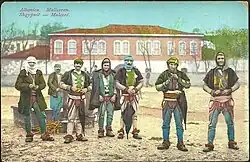| Part of a series on |
| Albanian tribes |
|---|
 |
The Oroshi tribe is an Albanian tribe and one of the bajraks of the ethnographic Mirdita region in northern central Albania. The Oroshi tribe was one of the three traditional bajraks of Mirdita, which has now increased to five.
Geography
Oroshi tribal territory is situated on the left (south and south-eastern) bank of the Lesser Fan River in the Mirdita region. Oroshi territory borders the Kushneni tribe to the west, the Spaçi and Fani tribes to the north, the Lura tribe to the east, and the Kthella and Selita tribes to the south. The mains ettlements of the Oroshi tribe are Orosh and Mashtërkor.[1]
Origins
The ancestral father of the Oroshi tribe was Mark Biba, son of Bib Kola. Mark was the brother of Dodë Biba, the ancestral father of the Spaçi tribe, and Gjin Biba, the ancestral father of the Kushneni tribe. As such, the Oroshi tribe was one of the three traditional bajraks of Mirdita before the number increased to five. All three sons hailed from the Pashtrik region near Gjakova in Kosovo, from where they migrated to what is now Oroshi tribal territory in Mirdita.[2][3]
History
The term 'Oroshi' is first mentioned as Orosci in an Italian report in 1671. It is further mentioned as Orosci, Orossi or in a variety of maps and ecclesiastical reports in 1688 with 30 homes, 1689 and 1703. It is also mentioned as Orocher in 1821. In 1881, it was recorded with 1,500-1,800 members. In 1895, they were recorded with 80 homes. In an Austro-Hungarian census taken in Albania during 1918, the Oroshi tribe were recorded as having 156 households with a total of 1,160 inhabitants. This comprised the settlement and surroundings of Orosh. In the 19th century, the settlement of Orosh was home to the "princes" of Mirdita, and was thus considered the capital of the composite Mirdita tribe.[4][5]
Religion
The Oroshi tribe is traditionally an entirely Catholic tribe. Its patron saint is Saint Alexander (Shën Llesh), to whom the most notable church in Mirdita - the old Abbey of Saint Alexander - was dedicated. This abbey is located in the settlement of Orosh and was first mentioned in 1313, supposedly having been founded by the Benedictines and the Basilians.[6]
Relation with other tribes
Due to the fact that the Oroshi tribe is one of the original three bajraks of Mirdita alongside the Kushneni and Spaçi tribes, members of the three tribes are consanguineous and therefore do not intermarry with each other. Members of the Oroshi can, however, intermarry with members of the Dibrri or Fani, the other two bajraks of Mirdita. In the 1860s, it was noted that although the Oroshi tribe had the lowest population and manpower of all the tribes in Mirdita, they still held general command over all of the bajraks of Mirdita.[7]
References
- ↑ Elsie, Robert (Apr 24, 2015). The Tribes of Albania: History, Society and Culture. Bloomsbury Publishing. pp. 250–251. ISBN 9780857725868.
- ↑ Elsie, Robert (Apr 24, 2015). The Tribes of Albania: History, Society and Culture. Bloomsbury Publishing. p. 250-251. ISBN 9780857725868.
- ↑ Valentini, Giuseppe (1956). Il Diritto delle Comunità - Nella Tradizione Giuridica Albanese. Florence: Vallecchi Editore. pp. 328–329.
- ↑ Elsie, Robert (Apr 24, 2015). The Tribes of Albania: History, Society and Culture. Bloomsbury Publishing. p. 251. ISBN 9780857725868.
- ↑ Valentini, Giuseppe (1956). Il Diritto delle Comunità - Nella Tradizione Giuridica Albanese. Florence: Vallecchi Editore. pp. 328–329.
- ↑ Elsie, Robert (Apr 24, 2015). The Tribes of Albania: History, Society and Culture. Bloomsbury Publishing. p. 251. ISBN 9780857725868.
- ↑ Elsie, Robert (Apr 24, 2015). The Tribes of Albania: History, Society and Culture. Bloomsbury Publishing. p. 251. ISBN 9780857725868.